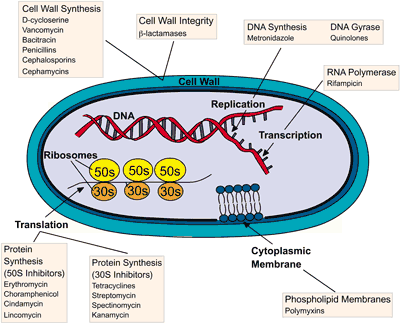 Five Basic Mechanisms of Antibiotic Action against Bacterial Cells:
Five Basic Mechanisms of Antibiotic Action against Bacterial Cells:
- Inhibition of Cell Wall Synthesis (most common mechanism)
- Inhibition of Protein Synthesis (Translation) (second largest class)
- Alteration of Cell Membranes
- Inhibition of Nucleic Acid Synthesis
- Antimetabolite Activity
 Inhibition of Cell Wall Synthesis
Inhibition of Cell Wall Synthesis
Beta-Lactams ---> Inhibition of peptidoglycan synthesis (bactericidal)
Resistance --->Vancomycin ---> Disrupts peptidoglycan cross-linkage
(1) fails to cross membrane (gram negatives)
(2) fails to bind to altered PBP’s
(3) hydrolysis by beta-lactamases
Resistance --->Bacitracin ---> Disrupts movement of peptidoglycan precursors (topical use)
(1) fails to cross gram negative outer membrane (too large)
(2) some intrinsically resistant (pentapeptide terminus)
Resistance ---> fails to penetrate into cellAntimycobacterial agents ---> Disrupt mycolic acid or arabinoglycan synthesis (bactericidal)
Resistance --->
(1) reduced uptake
(2) alteration of target sites
 Inhibition of Protein Synthesis (Translation)
Inhibition of Protein Synthesis (Translation)
30S Ribosome site
Aminoglycosides ---> Irreversibly bind 30S ribosomal proteins (bactericidal)
Resistance --->Tetracyclines ---> Block tRNA binding to 30S ribosome-mRNA complex (b-static)
(1) mutation of ribosomal binding site
(2) decreased uptake
(3) enzymatic modification of antibiotic
Resistance --->
(1) decreased penetration
(2) active efflux of antibiotic out of cell
(3) protection of 30S ribosome50S Ribosome site
Chloramphenicol ---> Binds peptidyl transferase component of 50S ribosome, blocking peptide elongation (bacteriostatic)
Resistance --->Macrolides ---> Reversibly bind 50S ribosome, block peptide elongation (b-static)
(1) plasmid-encoded chloramphenicol transferase
(2) altered outer membrane (chromosomal mutations)
Resistance --->Clindamycin ---> Binds 50S ribosome, blocks peptide elongation; Inhibits peptidyl transferase by interfering with binding of amino acid-acyl-tRNA complex
(1) methylation of 23S ribosomal RNA subunit
(2) enzymatic cleavage (erythromycin esterase)
(3) active efflux
Resistance ---> methylation of 23S ribosomal RNA subunit
 Alteration of Cell Membranes
Alteration of Cell Membranes
Polymyxins (topical) ---> Cationic detergent-like activity (topical use)
Resistance ---> inability to penetrate outer membraneBacitracin (topical) ---> Disrupt cytoplasmic membranes
Resistance ---> inability to penetrate outer membrane
 Inhibition of Nucleic Acid Synthesis
Inhibition of Nucleic Acid Synthesis
DNA Effects
Quinolones ---> Inhibit DNA gyrases or topoisomerases required for supercoiling of DNA; bind to alpha subunit
Resistance --->Metronidazole ---> Metabolic cytotoxic byproducts disrupt DNA
(1) alteration of alpha subunit of DNA gyrase (chromosomal)
(2) decreased uptake by alteration of porins (chromosomal)
Resistance --->
(1) decreased uptake
(2) elimination of toxic compounds before they interactRNA Effects (Transcription)
Rifampin ---> Binds to DNA-dependent RNA polymerase inhibiting initiation & Rifabutin of RNA synthesis
Resistance --->Bacitracin (topical) ---> Inhibits RNA transcription
(1) altered of beta subunit of RNA polymerase (chromosomal)
(2) intrinsic resistance in gram negatives (decreased uptake)
Resistance ---> inability to penetrate outer membrane
 Antimetabolite Activity
Antimetabolite Activity
https://www.youtube.com/watch?v=NGwP471sehISulfonamides & Dapsone ---> Compete with p-aminobenzoic acid (PABA) preventing synthesis of folic acid
Resistance ---> permeability barriers (e.g., Pseudomonas)Trimethoprim ---> Inhibit dihydrofolate reductase preventing synthesis of folic acid
Resistance --->Trimethoprim-Sulfamethoxazole synergism
(1) decreased affinity of dihydrofolate reductase
(2) intrinsic resistance if use exogenous thymidine

No comments:
Post a Comment